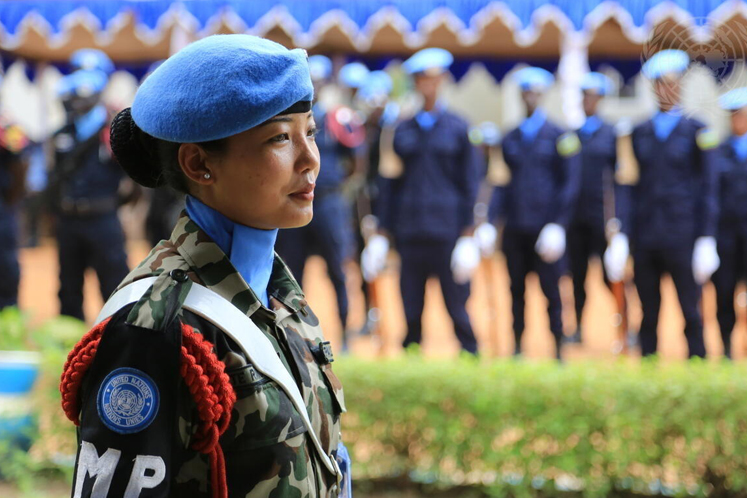5 steps to reach the 2028 targets for gender parity in peacekeeping
Did you know that out of all UN military peacekeepers, only 7% are women? In the member-state formed police units, women made up just 16% last year, while the total number of women police officers in UN operations was only 19%. It is a far cry from the targets set by the 2028 UN Gender Parity Strategy of 30% women in field missions and 35% in UN headquarters.
Since 2018, the number of women deployed to peacekeeping operations have steadily increased. Yet, at the global level women remain underrepresented – and men overrepresented - in UN peace operations.
Growing numbers is good, but not sufficient. It must be meaningful participation, meaning that women have the same opportunities, roles, and resources as men; where their needs are met, and their skill sets are matched to the responsibilities and expectations they face on the job.

Tara Yonjan, vehicle mechanic, with two of her colleagues from the Nepalese Contingent
in South Lebanon. Tara is the only woman on her team. Photo: UN Photo/Pasqual Gorriz
Recruiting peacekeepers from a larger pool of the population, rather than just 50% of it, increases the likelihood that those selected will be the best-suited and most effective on the job. For instance, there is evidence that people are more likely to approach women peacekeepers to report sexual abuse or harassment. This doesn’t mean there should be more women peacekeepers simply to fulfil special roles or “add value”. Rather, it demonstrates the need for greater equality and diversity in general in peace operations.
A peace operation that is more diverse and reflective of the population it serves is generally seen as more legitimate by the local population.
There are concrete steps that countries can take to improve opportunities for women to participate meaningfully in peace operations, and several have made good progress towards a better gender-balance in their peacekeeping deployments.
INSPIRING EXAMPLES TO GO BY

With four more years to go, the parity target is still within reach. But it will require increased
efforts by UN member states to put in place the resources, budgets, and policies that support
the deployment of men and women equally. Photo: UN Photo/Nektarios Markogiannis
In 2023, Ghana and Nepal exceeded the target of 15% of deployed women for both UN military observers and troops. South Africa, Cambodia, Zambia, and Nigeria were also well above the target for women serving in military contingents.
Among other countries, Ghana, Zambia, and Cambodia have taken steps to improve their internal policies and practices through self-assessments using the Elsie Initiative’s Measuring Opportunities for Women in Peace Operations (MOWIP) methodology.
With four more years to go, the parity target is still within reach. But it will require increased efforts by national and international stakeholders to remove barriers and improve opportunities for women to serve.
With the commitment of senior leaders, and changes in policies and practices at the operational level, it is possible. After all, especially in these times of rising conflict, more effective peacekeeping and peacebuilding is in everyone's interest.
FIVE STEPS TO REACHING PARITY TARGETS IN PEACEKEEPING OPERATIONS
- Stop restricting deployment opportunities based on explicit or implicit gender bias. Women and men can serve in all roles in peace operations where social skills, such as tension management and mediation, are as important as combat skills.
- Raise awareness among uniformed personnel of employment opportunities in peace operations, and highlight women role models and mentors.
- Increase opportunities for training and development for women to meet qualification requirements for UN assignments. Ensure that their new skills and abilities gained from serving as a peacekeeper are valued by their institution when they return home.
- Improve family-friendly policies so that men and women with caregiving responsibilities can go on deployment knowing that their families will be supported, and that will be able to return home during their mission to see them.
- Improve psycho-social support and mental health services for men and women serving in peace operations before, during, and after deployment - and do the same for their families at home.
Read more on the topic:
- Uniformed Gender Parity Strategy 2018-2028 (full text) | United Nations Peacekeeping
- Women in Multilateral Peace Operations in 2023: What is the State of Play?
- The Elsie Initiative Fund
- Global MOWIP Report
- Elsie Initiative for Women in Peace Operations: Baseline Study
Cover photo: UN Photo/Harandane Dicko
 Share on Facebook
Share on Facebook Share on Linkedin
Share on Linkedin Share on Twitter
Share on Twitter